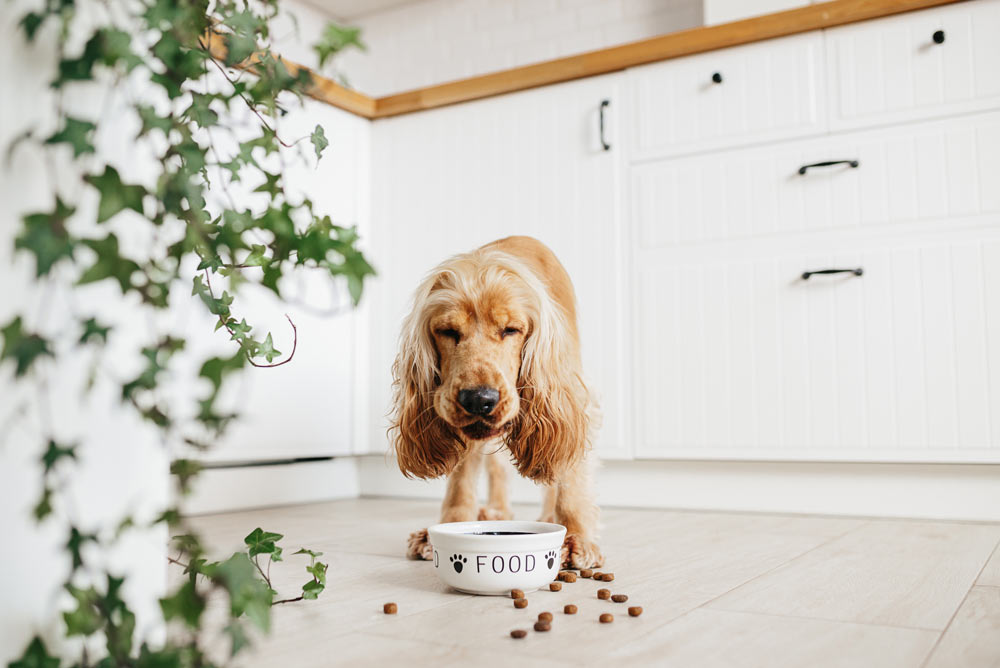
How Often & How Much Should I Feed My Dog?
Written by Chris Vanderhoof, DVM, MPH
There are a ton of different types of dog foods and feeding choices available for pups. Therefore, there's a few ways to answer the question: how much should I feed my dog?
But regardless of what you feed, it’s also important to know how to feed. In this article, you’ll learn the basics of measuring out the right portions for your dog, just like your vet would, to keep her at a healthy weight.
You’ll also learn some tips on how often you should feed and perhaps most importantly, you’ll gain a valuable tool to figure out exactly how much food to feed your pup, regardless of what diet it is.

How to Measure Dog Food Portions
One of the most common questions veterinarians get regarding food is how much to feed. According to the Association of Pet Obesity Prevention, more than half of dogs in the United States are overweight or obese, so it’s no surprise that many pup parents are very conscious about their dog’s weight and how much food amount and feeding schedule are contributing.
To know how much to feed, it’s important to understand calories. On the back of any can of food or on the side of any bag, you’ll see a listing of nutritional information. At the bottom, you’ll see the value of kilocalories per can or cup of food.

A kilocalorie (or Calorie) is a unit of energy in food. Each of us, pups and people alike, require a certain amount of kilocalories per day for our normal body function. The more active we are, the higher our energy demands.
When the amount of kilocalories we’re consuming from food exceeds what our bodies need, all of that extra energy gets stored. And this is how weight gain occurs.
So, to avoid extra weight gain, the important thing to do is to match what your dog needs with how much food is being taken in. We can then translate that Calorie amount into the amount to feed per day and split that daily amount into desired portions.
Dog Feeding Formula
If you want to know how much to feed your dog, just like how your vet would figure it out, you’ll have to do a little simple math. That’s the bad news. The good news is, you’ll be able to use this calculation for any food whether it’s canned, dry, treats, or even home-cooked food.
First, you need to know your dog’s weight in pounds or kilograms. If in pounds, you’ll need to divide by a factor of 2.2 to get kilograms. If you’re already in kilograms, that’s great, just stay there!
When you’ve got your weight in kilograms, multiply it by a factor of 30. Once you’ve done that, add 70. The number you get will be roughly what’s called the resting energy requirement, or RER. The resting energy requirement is the number of kilocalories needed per day for the body’s basic needs.
Here’s an example. If your pup weighs 22 pounds, you’d first divide by 2.2 to get the weight in kilograms, which would be 10. Now multiply by 30 to get 300, and add 70 to get an RER of 370 kilocalories, or kcal.
But that’s just our first step. Dogs all have different levels of activity. And, depending on whether your dog is a puppy, adult, or senior pooch, your furry friend will also have specific energy requirements.
To get your dog’s total daily energy needs per day, you’ll need to multiply that RER value by an additional factor. Using the dog feeding chart below that contains generally accepted life stage and activity factors, you’ll be able to determine the final feeding amount your dog would need per day.
|
Intact (non-neutered) adult |
1.8 |
|
Neutered adult |
1.6 |
|
Inactive or prone to obesity |
1.2-1.4 |
|
Desired weight loss |
0.8-1.0 x RER for estimated ideal weight |
|
Desired weight gain |
1.4-1.8 x RER for estimated ideal weight |
|
Puppy 0-4 months |
3.0 |
|
Puppy 4 months - adult |
2.0 |
|
Active/working dogs |
2.0-5.0 depending on activity level |
So, let’s take our 22 pound dog and say that he’s a neutered dog with an average activity level. We’d take the RER value of 370 that we got earlier, and multiply it by the neutered adult factor of 1.6 to get a final daily requirement of 592.
But now let’s say that our 22 pound pup is overweight and we’d like to figure out a plan for weight loss. If his ideal weight is more like 15 pounds, we would use this ideal weight to calculate the RER, which is about 275. Now, multiply by the weight loss factor of 0.8-1.0, to get a range of 220 to 275.
While this process is a bit simplified for ease of use, and many veterinarians use a more complex form of this formula, this is a good starting point to use as a guide.
How Do I Use This Dog Feeding Chart and Formula?

Once you’ve calculated your pup’s daily energy requirement, you take that number and divide it by the kilocalories per can or cup listed on the food packaging. The resulting number will be how many cups or cans to feed per day.
Using our previous example of our average neutered dog with a daily requirement of 592 calories, let’s say we’re feeding a dry/kibble food containing 385 kcal per cup.
Dividing 592 by 385 would give us about 1.5, or one and a half cups per day.
You can use this for any food or combinations of foods. If home cooking, you need to figure out the Calories contained in each ingredient and add them up to determine the diet’s total value in Calories/kilocalories.
How Many Times a Day Should I Feed My Dog?

Now that you’ve figured out how many Calories your pooch needs per day and how many cups or cans this equates to, how do you decide how to split up that amount?
Feeding frequency may depend both on your schedule as well as what your pup prefers.
Generally, feeding smaller, more frequent meals is better, because it encourages a higher metabolism and is better for digestion. However, 3-4 meals a day may not be feasible for everyone. That’s why most folks feed their dogs in the morning and again in the evening.
But if you happen to work from home and can add a third or fourth meal, go for it.
Some folks find that their dogs prefer to eat only once a day, or may sometimes skip meals, or prefer grazing over a couple of hours. If you’ve established through living with your pup and getting to know her that this is the routine, this may be okay, but make sure to ask your vet to see if different eating habits may indicate any underlying health concerns.
How Often Should I Feed My Puppy?

Feeding puppies can be a little different from feeding adult dogs. Young puppies nurse their mom often, and so very young puppies who are transitioning over to food are used to eating more frequently. It is very common to feed a puppy at least 3 times a day through about 12 weeks of age.
If your schedule does not allow for feeding your pup every 8 hours, it is okay to transition to twice daily feeding after that point.
What About Treats?

Any dog lover knows just how much dogs love their treats. Cutting treats out of a diet is disappointing for both pup and pup parent.
The good news is, you don’t have to cut treats out completely, but you do have to regulate the percentage of the daily diet that they make up. The general rule is to keep treats to just 10% of the daily energy requirement.
For our average dog from our previous examples who can have 592 Calories per day, this would be about 60 Calories. This would leave about 500 Calories left for the main diet.
Even for our dog that needed to lose some weight, who only needs 275 Calories per day, that could still leave us about 30 Calories per day for treats.
To Learn More About Dog Feeding, Schedule a Visit with Your Vet
This article has some simple basics to get started. If you have additional questions about the best diet for your dog, what kind of schedule might be best, and if any changes in your pup’s eating habits could indicate a health concern, make sure to chat with your pup’s doc to get the most specific information catered to your dog’s needs.
JOIN OUR PACK
Follow us @NaturVet on social media to fill us in on any tips we might have missed. And, check out the rest of NaturVet.com. We’ll keep you up to date on all our latest pet resources, supplements, tips and tricks, and more – everything you need to be the best pet parent possible.







